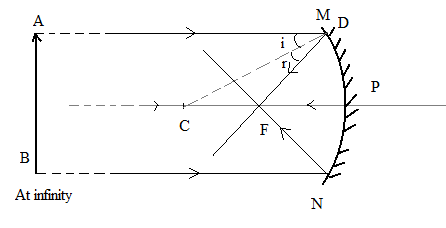
Why does obtaining the image of the sun on a paper with the help of a concave mirror burn the paper?
Answer
471.6k+ views
Hint: When the light reflects back from a mirror, none of it is absorbed, its energy is completely reflected back. A concave mirror is a type of spherical mirror in which the concave part is the reflecting part.
Complete answer:
Light is a form of energy which enables us to see.
Mirrors are silvered surfaces which have the ability to reflect maximum light energy when it strikes the mirror.
Mirrors can be classified into two types. First, the plane mirror, in which the surface which is silvered is a plane surface. Second, the spherical mirror, in which the surface which is silvered is a spherical surface.
Spherical mirrors can further be classified into concave and convex mirrors. In concave mirrors the concave part is silver whereas in convex mirrors, the convex part is silvered.
The centre of the sphere from which the concave mirror is made is known as the centre of curvature
Since the distance of the sun from the mirror is very large therefore, the light rays coming from the sun can be considered as coming from infinity. All the rays coming from infinity meet at the focus

Note: The point at which two or more reflected rays meet is known as an image. When the rays actually meet after getting reflected, the image is known as a real image. Whereas when the rays do not actually meet after getting reflected but appear to meet virtually behind the mirror, the image formed is known as a virtual image.
Complete answer:
Light is a form of energy which enables us to see.
Mirrors are silvered surfaces which have the ability to reflect maximum light energy when it strikes the mirror.
Mirrors can be classified into two types. First, the plane mirror, in which the surface which is silvered is a plane surface. Second, the spherical mirror, in which the surface which is silvered is a spherical surface.
Spherical mirrors can further be classified into concave and convex mirrors. In concave mirrors the concave part is silver whereas in convex mirrors, the convex part is silvered.
The centre of the sphere from which the concave mirror is made is known as the centre of curvature
Since the distance of the sun from the mirror is very large therefore, the light rays coming from the sun can be considered as coming from infinity. All the rays coming from infinity meet at the focus

Note: The point at which two or more reflected rays meet is known as an image. When the rays actually meet after getting reflected, the image is known as a real image. Whereas when the rays do not actually meet after getting reflected but appear to meet virtually behind the mirror, the image formed is known as a virtual image.
Recently Updated Pages
Master Class 12 Economics: Engaging Questions & Answers for Success

Master Class 12 Maths: Engaging Questions & Answers for Success

Master Class 12 Biology: Engaging Questions & Answers for Success

Master Class 12 Physics: Engaging Questions & Answers for Success

Master Class 4 Maths: Engaging Questions & Answers for Success

Master Class 4 English: Engaging Questions & Answers for Success

Trending doubts
Give 10 examples of unisexual and bisexual flowers

Draw a labelled sketch of the human eye class 12 physics CBSE

a Tabulate the differences in the characteristics of class 12 chemistry CBSE

Differentiate between homogeneous and heterogeneous class 12 chemistry CBSE

Why is the cell called the structural and functional class 12 biology CBSE

Differentiate between insitu conservation and exsitu class 12 biology CBSE




